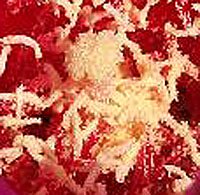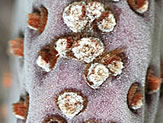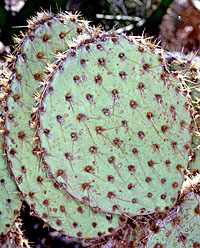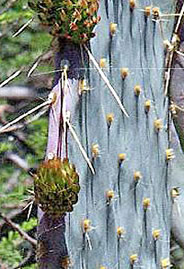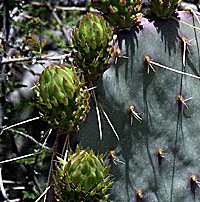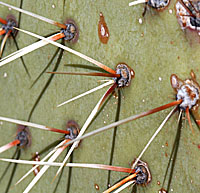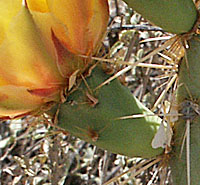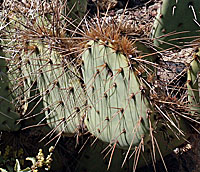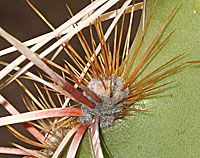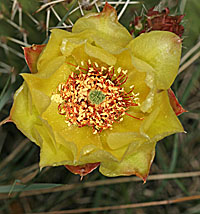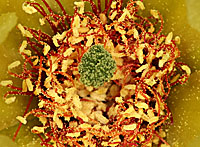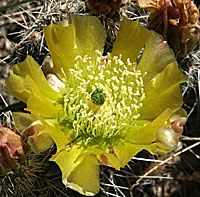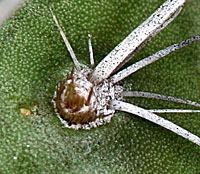Opuntia Genus
Cactus Family
Opuntias are the pricklly pear cacti. The plant is composed of flat pads. Glochids are present at the aeroles. Large spines are usually, but not always present. Classification at the species level is often rather difficult. The opuntias hybridize creating intergradations between species. For example, in the west foothills of the Sandia Mountains at 6,200 foot elevation Opuntia engelmanii, Opuntia polycantha, and Opuntia erinacea are common. Clear examples of each species abound. Examples of species with characteristics intermediate between erinacea and polycantha are also observed. Similiar descriptions are noted in many references.
Distinguishing between the different species of Opuntia can be difficult. To aid this process check the pages sorting opuntia (A-E), sorting Opuntia (E-R) and sorting opuntia (S-T). The most important single characteristic is location, then elevation. Next is the overall size of the plant. Remaining characteristics are those in the "sorting opuntia" pages. Note each characteristic before attempting an identification because many species hybridize. For more complete material see the "efloras" link below. Many of the characteristics herein are derived from efloras, Weber, or Harrington.
Generally the larger opuntias occur at the lower elevations in the warmer climes, for example in southern Arizona or around Big Bend, Texas. Smaller and medium sized opuntias tend to be widespread, for example fragilis and polycantha which occur througout the rocky mountain region. The genetic differences between the Opuntia are confusing to this author. They may eventually lead to a better classification of the opuntia. Presentlly the species are separated by the observed differences noted in the "sorting opuntia" links above.
| Opuntia |
Beavertail Prickly Pear |
|
 |
|
 |
Beavertail Prickly Pear, Opuntia basilaris (basal), growing at the Sonoran Desert Museum just west of Tucson, Arizona, and at Valley of Fires State Park, Utah.
|
|||||
Opuntia |
Pancake Prickly Pear
|
|
|
|
|
Native of Sonoran and perhaps Mohave Deserts. |
|||||
Opuntia |
engelmanii |
|
|
|
|
| Opuntia engelmanii, Engelmann's Prickly Pear is a robust prickly pear with relatively large pads. Pads are 6 to 8 in. (15 to 20 cm )acoss, aeroles are about 32 mm apart, central spines 35 mm long with 1 central and 2-3 radial. Pad thickness is 15 mm. Occurs in California, Arizona, Nevada, Utah, New Mexico and fairly far east into Texas, but not in Colorado. A number of varieties of engelmanii occur. In general the pads are large, the plants are erect and large, and the spines range from sparse to moderately dense. |
|||||
| Opuntia |
erinacea var hystricina (erinacea) |
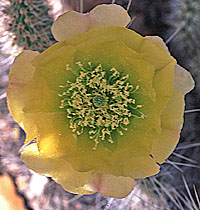 |
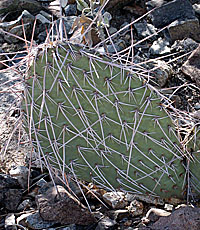 |
 |
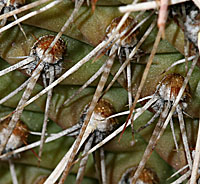 |
Porcupine Prickly Pear, Opuntia erinacea hystricina (Gr. hedgehog, porcupine), growing at the Sonoran Desert Museum, 2,560 Feet elevation, March 7, 2007. Very densely spined prickly pear with small pads, pad dia 75 mm.,Spines 1-2 central about 37mm long, aeroles 7mm apart, radial spines about 9, len up to 25mm. radial spines ranked in two sizes, pad width 23 mm. Erinacea pads are smaller (5-19 cm long, 3-11 cm wide ) than those of phaecantha (10-40 cm. long, 7-25 cm wide) and polycantha (5-15 cm long, 4-12 cm. wide). Numerous varieties occur including ursina, in which the spines are so dense that the pads cannot be observed. This variety is called Grizzly Bear Prickly Pear. Glochids in a caplike arrangement. Aeroles 8-14 per diagonal row across the pad. This flower is yellow with a greenish center but this is not generally distinctive. Note in some references erinacea is now considered a varity of polycantha. |
|||||
| Opuntia |
Brown Spined Prickly Pear |
|
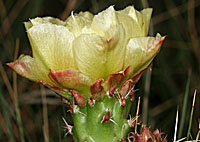 |
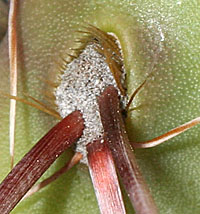 |
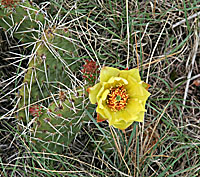 |
| Distinctive characteristics: Pads smaller than engelmanii, larger than polycantha., glochids in cresent as above, tepals yellow often with red base, stamens red, pistils yellow. | |||||
| opuntia |
Many Spined Prickly Pear |
|
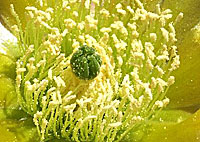 |
|
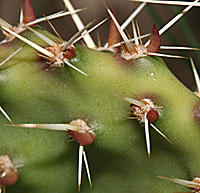 |
| Distinctive Characteristics: Pads smaller than phaecantha but larger than erinacea, distinctly wrinkled or bumpy, spines dense, but not as dense as erinacea, glochids in cresent with extra tuft as in figure above, flowers yellow to yellow green, with yellow filaments and pistils. |
|||||

